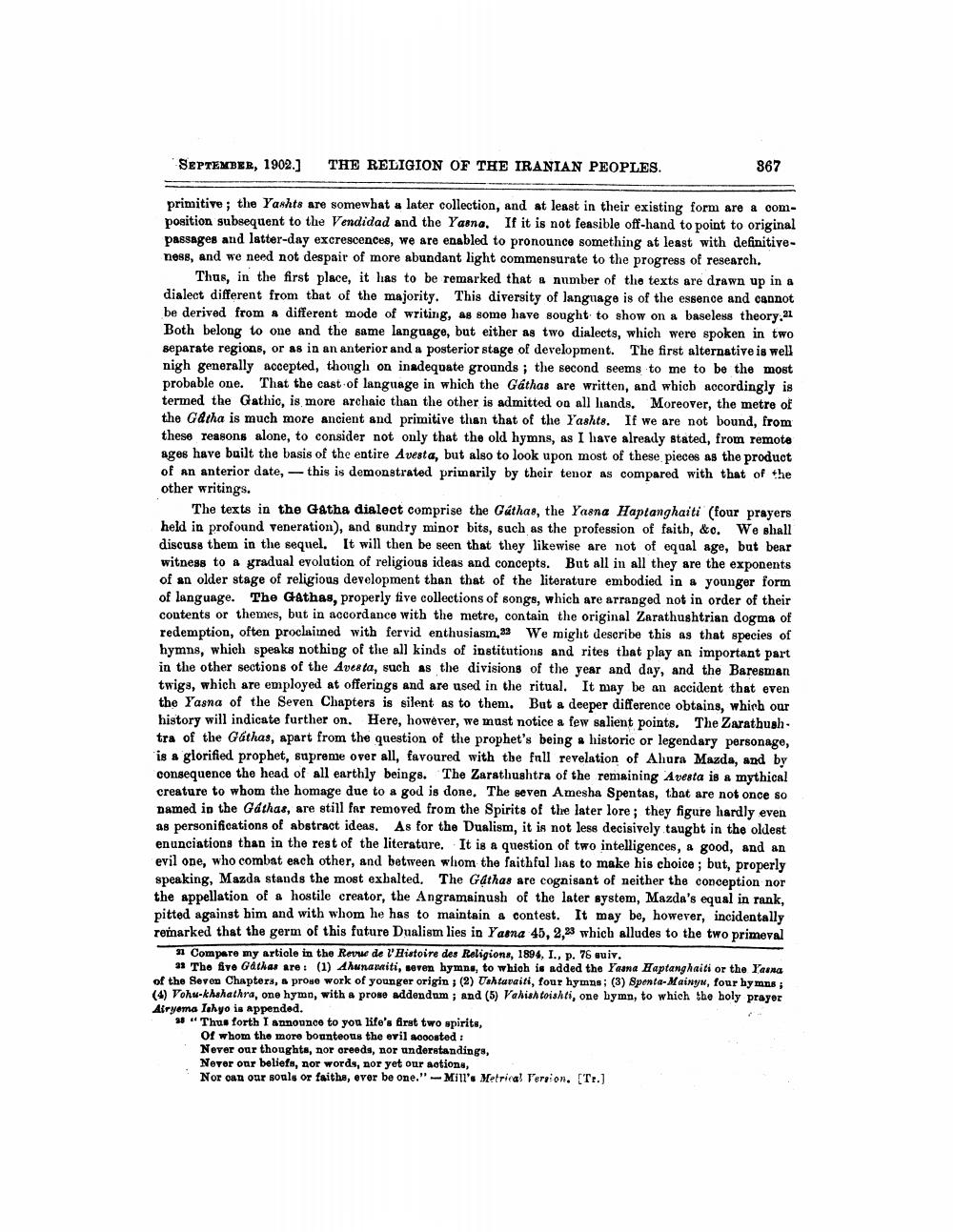________________
SEPTEMBER, 1902.]
THE RELIGION OF THE IRANIAN PEOPLES.
867
primitive; the Yanhts are somewhat a later collection, and at least in their existing form are a composition subsequent to the Vendidad and the Yasna. If it is not feasible off-hand to point to original passages and latter-day excrescences, we are enabled to pronounce something at least with definitiveness, and we need not despair of more abundant light commensurate to the progress of research.
Thus, in the first place, it has to be remarked that a number of the texts are drawn up in a dialect different from that of the majority. This diversity of language is of the essence and cannot be derived from a different mode of writing, as some have sought to show on a baseless theory,21 Both belong to one and the same language, but either as two dialects, which were spoken in two separate regions, or as in an anterior and a posterior stage of development. The first alternative is well nigh generally accepted, though on inadequate grounds; the second seems to me to be the most probable one. That the cast of language in which the Gathas are written, and which accordingly is termed the Gathic, is more archaic than the other is admitted on all hands. Moreover, the metre of the Gatha is much more ancient and primitive than that of the Yashts. If we are not bound, from these reasons alone, to consider not only that the old hymns, as I have already stated, from remote ages have built the basis of the entire Avesta, but also to look upon most of these pieces as the product of an anterior date, - this is demonstrated primarily by their tenor as compared with that of the other writings.
The texts in the Gatha dialect comprise the Gáthas, the Yasna Haptanghaiti (four prayers held in profound veneration), and sundry minor bits, such as the profession of faith, &o. We shall discuss them in the sequel. It will then be seen that they likewise are not of equal age, but bear witness to a gradual evolution of religious ideas and concepts. But all in all they are the exponents of an older stage of religious development than that of the literature embodied in a younger form of language. The Gathas, properly five collections of songs, which are arranged not in order of their contents or themes, but in accordance with the metre, contain the original Zarathushtrian dogma of redemption, often proclaimed with fervid enthusiasm 32 We might describe this as that species of hymns, which speaks nothing of the all kinds of institutions and rites that play an important part in the other sections of the Avesta, such as the divisions of the year and day, and the Baresman twigs, which are employed at offerings and are used in the ritual. It may be an accident that even the Yasna of the Seven Chapters is silent as to them. But a deeper difference obtains, which our history will indicate further on. Here, however, we must notice a few salient points. The Zarathush tra of the Gathas, apart from the question of the prophet's being a historic or legendary personage, is a glorified prophet, supreme over all, favoured with the full revelation of Ahura Mazda, and by consequence the head of all earthly beings. The Zarathustra of the remaining Avesta is a mythical creature to whom the homage due to a god is done. The seven Amesha Spentas, that are not once so Damed in the Gathas, are still fer removed from the Spirits of the later lore; they figure hardly even as personifications of abstract ideas. As for the Dualism, it is not less decisively taught in the oldest enunciations than in the rest of the literature. It is a question of two intelligences, a good, and an evil one, who combat each other, and between whom the faithful has to make his choice ; but, properly speaking, Mazda stands the most exbalted. The Gathas are cognisant of neither the conception nor the appellation of a hostile creator, the Angramainush of the later system, Mazda's equal in rank, pitted against him and with whom he has to maintain a contest. It may be, however, incidentally remarked that the germ of this future Dualism lies in Yasna 45, 2,23 which alludes to the two primeval
Compare my article in the Revue de l'Histoire des Religions, 1894, I., p. 76 suiv. a The five Gathas are: (1) Ahunamiti, seven hymns, to which is added the Yaana Heptanghaifi or the Yasna of the Seven Chapters, prose work of younger origin ; (2) Ushtaraiti, four hymns: (3) Spenta-Mainyn, four hymns ; (4) Vohu-khshathra, one hymn, with a prose addendum ; and (5) Vahish toishti, one bymn, to which the holy prayer Airyema Ishyo is appended. 35 "Thus forth I announce to you life's first two spirits,
Of whom the more bounteous the evil accosted: Never our thoughts, nor creeds, nor understandings, Never our beliefs, nor words, nor yet our actions, Nor can our souls or faithe, ever be one." - Mill's Metrical Terrion. (Tr.)




